by Ken Gargett
A long time ago, in another lifetime, I had finished a stint in a law firm in Washington, D.C. and had returned home to Brisbane for a week or two before starting with a new firm in Sydney.
My time in Brizzy (as it is known) happily coincided with a special Burgundy dinner run by some old friends. And special it was. As I am again in transit looking for new digs, I am unfortunately sans my old notebooks, but I remember the highlight of the night. It was a half-bottle of the 1947 Musigny from Faiveley.
The truly great Burgundies I have enjoyed over the years – those Burgundies that have really excited me – are a handful from Domaine de la Romanée-Conti plus one interloper: the 1947 Faiveley Musigny.
The day after the dinner, a Friday, my family drove down to Sydney for my relocation. I was due to start work on the Monday and, as one often does with new beginnings, I thought it time to make a few changes in the lifestyle. Better get fit (three months traveling around on an extended road trip with friends, plus various stints in hospitals, had left me a little below my peak – and my peak was always fairly unimpressive in any event).
A local bottle shop find: Faiveley 1947 Musigny
So on Saturday morning, on went the joggers and off I set, also to acquaint myself with my new neighborhood. I did not get far before I came across an old bottle shop, one of the famous Crittenden’s chain – this was still an era when families and independents owned the wine stores and bottle shops rather than having them split between our two big supermarket chains as they are today.
So much for my attempt at fitness. I am not in the least interested in shopping for almost anything, but I cannot walk past a bookstore, a fishing gear retailer, or a bottle shop. In I went.
It was one of those wonderful old chaotic stores, dimly lit, dust everywhere. Not like today’s bright, clinical, sterile stores where everything is computerized down to the last bottle top.
There was an attendant at the counter, but he was much more interested in the latest Mills and Boon novel, and I doubt if a herd of thundering rhinos had come through would he have budged. I was happy just exploring. And there, right down the back and under various mixed bottles, caked in dust, was a thing of beauty: a half-bottle of Faiveley 1947 Musigny.
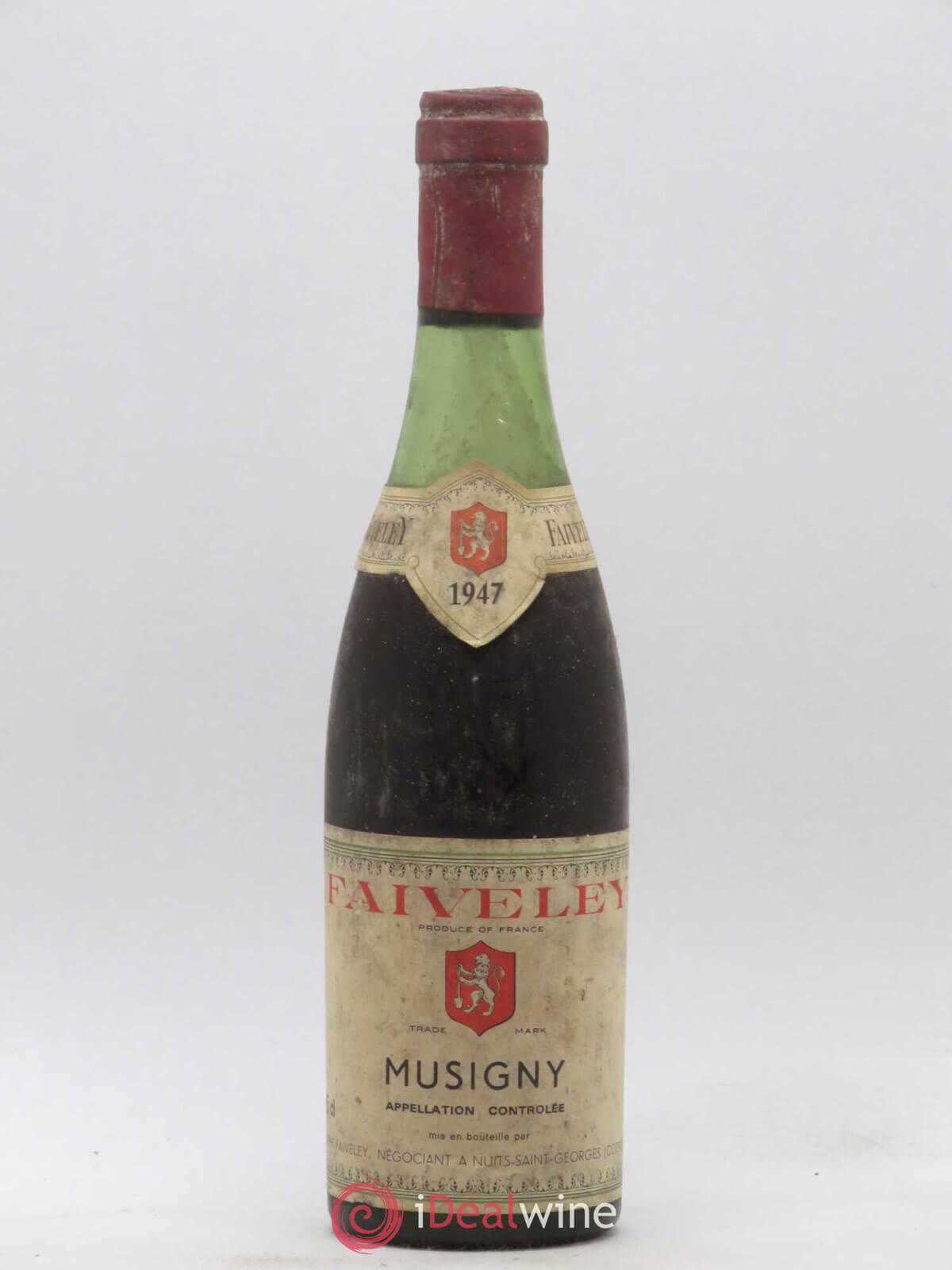
Caked in dust, a thing of beauty: 1947 Musigny (photo courtesy iDealwine.com)
Ever so carefully, I carried it up to the counter and waited. Our friend did not remove his nose from his romance novel. I coughed politely. Eventually, clearly annoyed, he looked up to see what had interrupted him. “Hi,” I said. He stared at me. I thought that this really could be going better. Were all people from Sydney this difficult?
“Hi,” I said again. “I wonder if you could tell me how much this is?”
He looked at me with utter disdain (granted, in joggers, shorts, and a sweaty old t-shirt I probably did not look like a promising customer) and said, “Expensive.” And went back to Messrs. Mills and Boon.
I was starting to get a bit annoyed but thought I’d really be better off remaining polite. So as courteously as I could asked, “How expensive?”
He marked his place and looked at me with outright hostility. “I’d have to go and look it up.” He seemed to presume that concluded our business and went back to M&B.
By now I’d almost bitten my tongue off but I said, as quietly as I could, “I wonder if you might be so kind.” The look I got suggested he would rather swallow ground glass and that he knew this would be a complete waste of time. He gave a huge sigh, made a big show of putting the placemark in his novel, and slowly drudged off (I was sorely tempted to change the placemark while he was absent).
After about five minutes – I did say this was pre-computerization of everything – he returned and sat down. He looked up at me as though he was rather surprised that I would still be there and disappointed that I was.
We looked at each other. Finally, with a sneer that would impress aspiring politicians, he said, “I told you it was expensive: $45.”
Given that I had spent the previous three months traveling and in hospitals, and the new job did not start for two days, I was in no position to splash the cash but $45 for this bottle, that I would do. Anyone want to buy a kidney?
More seriously, I said, still as politely as I could, “I wonder if you might hold this bottle for me while I zip home and grab the wallet?” From the look, you’d swear I’d asked him to spend a year cleaning the toilets at the local prison.
“I can’t promise it will still be here when you get back,” he said. Now, given that it had so much dust that I suspect you could have aged it like they do with tree rings, it seemed the demand was not overwhelming. And as I was the only person who’d been in the store the entire time, a flood of customers searching for old bottles of Burgundy seemed unlikely.
Nevertheless, I planned on wasting no time. I sprinted home – I figured that would cover the fitness lurk – and grabbed my wallet as my flat mate yelled out to find out what was happening. I told him I had no time to talk and raced for the car. I was back at the store in under ten minutes, but I reckon if there had been any other customer, Mr. Romance Novel would have sold it to them for nearly nothing just to annoy me. My bottle was still there.
I opened it about a decade later for a couple of friends who’d helped me out with various things and who were Burgundy fans. It was even better than I remembered. Glorious. Absolutely stunning.
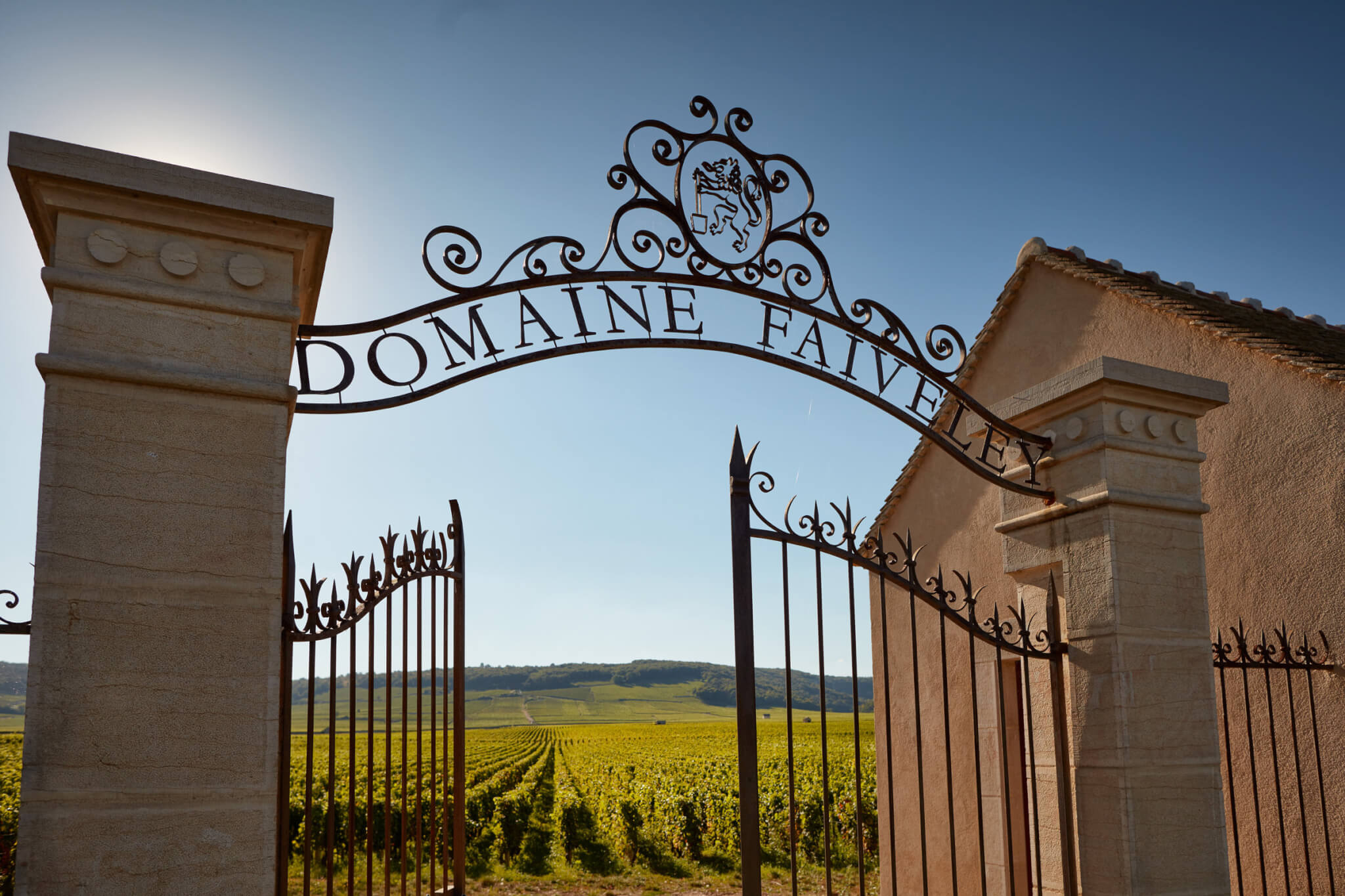
Domaine Faiveley (photo courtesy Faiveley/Serge Chapuis)
A Faiveley lunch
I was reminded of this when the lord and master of our little wine group gave the instructions for the theme for the next lunch: Faiveley Grand Cru. Could we be so lucky that someone might still have one of these halves given that there were apparently a fair number of them around many years earlier (spoiler alert: no, we were not that lucky).
Wine-obsessed friends older than myself would tell tales of enjoying this wine regularly many years earlier. One clearly recalls buying a case for the outrageous sum of $9 a half-bottle. Some years later, he purchased another case and was disappointed to learn that they had gone up to the mid-$20s. No matter. I still think I got the bargain of a lifetime.
Rumors abounded as to why we had so much of this wine in Australia. Musigny does not grow on trees (yes, it grows on vines, but you know what I mean). One story was that the local importer had brought in magnums that he been unable to sell and so transferred them to halves. The problem with this was that it made no sense, and the halves were labeled properly. Where would he have got labels? This was in the time before fakes were so common, so I doubt that crossed anyone’s mind.
With the lunch upon us, I thought I’d see what I could find out and so I dropped a note to the current head of the house, Erwan Faiveley, to see if he could assist. Erwan runs the house with his sister Eve, taking over from their father, François, in 2005 (Eve joined nearly a decade later). They are the seventh generation, and Eve is the first daughter in all that time.
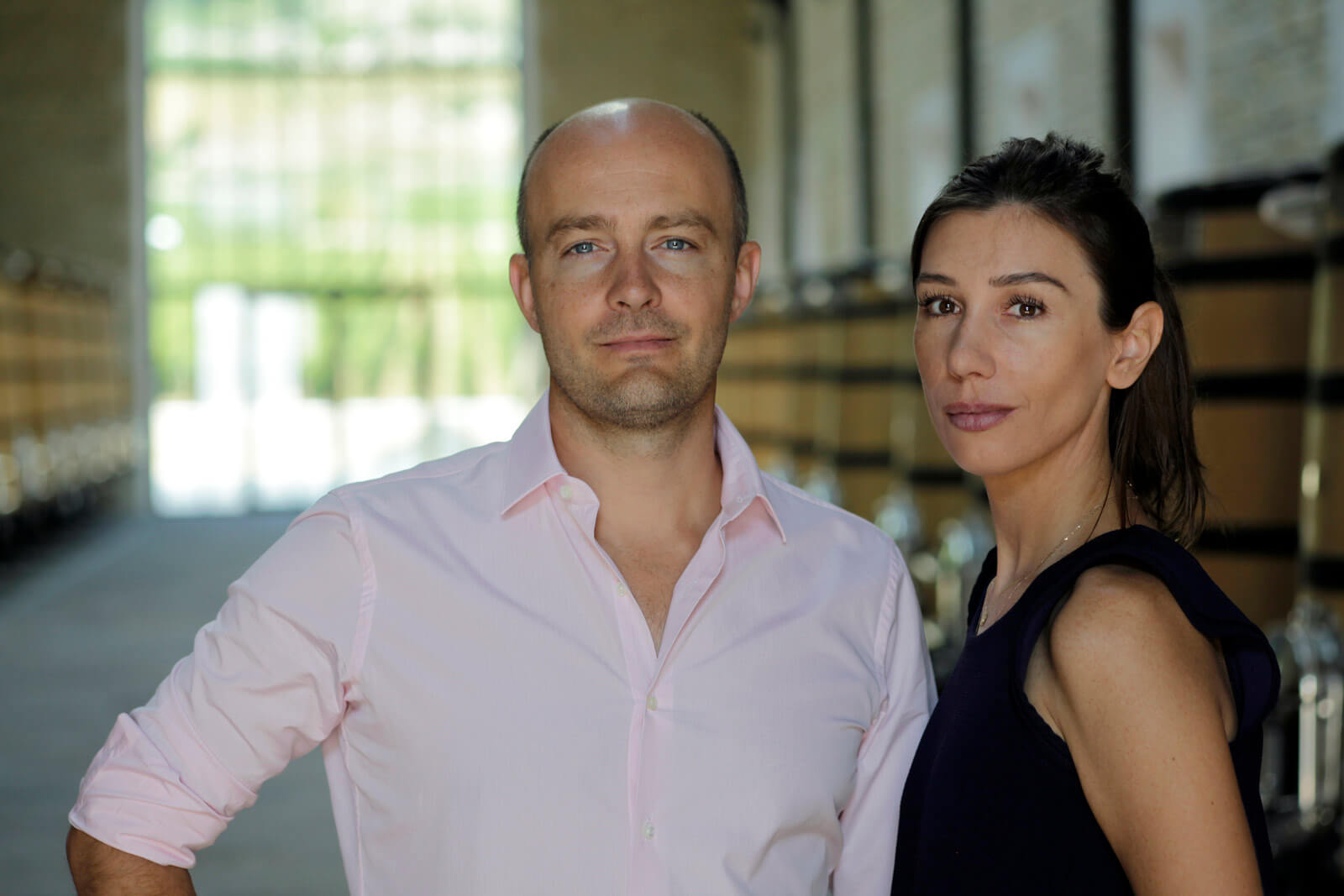
Erwan and Eve Faiveley (photo courtesy Faiveley/Mark Volk)
Erwan was just 25 when he took the reins – extraordinarily young to take charge of such a large and illustrious domaine. On the evidence to date, the change in management has worked wonderfully well.
Erwan doesn’t know me from Adam, as we say, and presumably has far more important things to do than spend his time answering unsolicited enquiries. Yet he immediately took the time to check into this and respond. You really have to love the wine industry. Where else would the head of a major producer take time to respond like that? Can’t imagine the head of Ford or General Motors writing back to a curious busybody.
Anyway, Erwan very kindly spoke with his father to check this – he has seen the wine on a couple of occasions and also thought it a wonderful one. He was aware that this was a very well represented vintage, though not why. Erwan told me that the wine was made by his great-grandfather, Georges Faiveley. As he said, “Often, when he really liked a wine, he had it bottled in halves, mostly for his own consumption (the famous PMG “Pour Ma Gueule”). He must have loved that wine too much, as many of them ended up on the market :-)”
The information available on Faiveley’s tiny plot as it currently stands suggests that the vineyard was planted in 1945, a plot of around 0.03 hectares according the Jasper Morris book Inside Burgundy. Which begs the question as to just where that ’47 came from as the vines would not have been producing so young.
The Faiveleys do not have records as to who owned it previously, but it is believed to have been acquired in the 1930s by Erwan’s great-grandfather. There are enough reports to confirm earlier vintages as well.
It seems very likely that these examples of Musigny may have been from the negociants’ side of the business. In 2016, the Faiveleys acquired a further 0.0980 hectares of Musigny from the house of Dufouleur Frères.
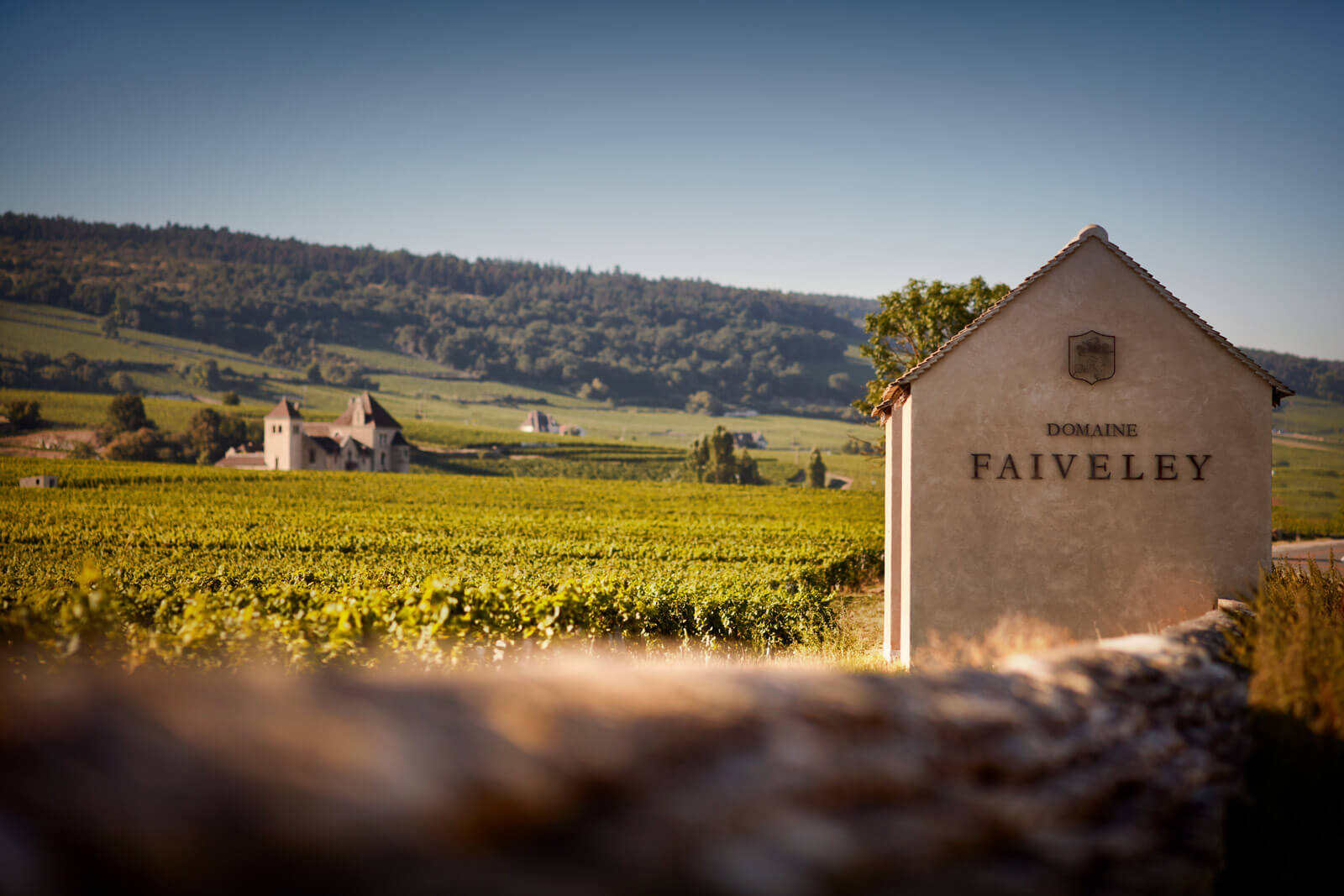
Faiveley Clos Vougeot vineyard (photo courtesy Faiveley/Serge Chapuis)
This brings Faiveley’s total holdings from that appellation to 0.1318 hectares. The new section of the vineyard is not contiguous with the original plantings. This will considerably increase production, but in reality the Musigny will still be a drop in the ocean.
The proposed lunch. As usual, the response to the theme was divisive – is there anything involved with great wine that is not? Some were delighted, others dismissive. Personally, my view of Faiveley has been that it has always been a very solid house with some real highlights. But it is a producer whose wines needed time. If you open them too early, you’ll get muscular and burly wines, lacking finesse and elegance. But give them time and they can blossom into some truly stunning Burgundies.
Like most of these things, views on such matters are not always aligned. I have heard one friend tell another not to bother bringing a Faiveley Echezeaux to a lunch. He wanted something better (I have also seen the same gentleman tell another friend that he had to do better than a 1990 Mouton-Rothschild – a hard school!). Another decided not to even bother attending this most recent event, convinced that Faiveley did not stack up. Burgundy can bring forth stronger views than even politics, and there is no snob like a Burgundy snob!
What is important to note is that since Erwan and Eve took over, they have worked hard to transform the house and improve the wines. What I have described was the situation before their reign.
The style has changed since 2007 (Jerome Flous joined as winemaker that year). We now have Burgundies offering finesse and elegance rather than the muscular power of previous eras. There is less reliance on extraction. Intensity has been maintained but the often heavily tannic structure has been reduced and softened.
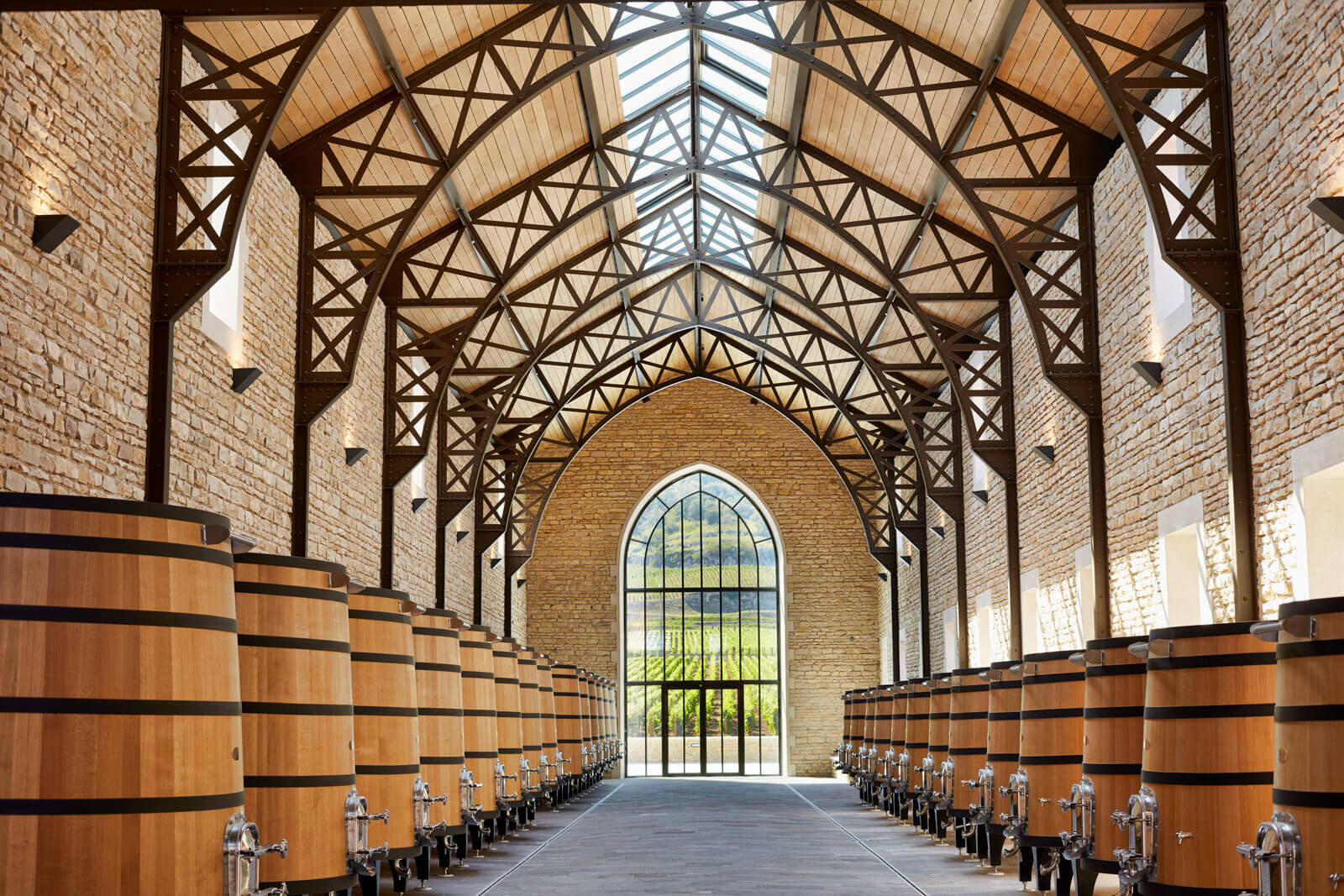
Faiveley wine barrel hall (photo courtesy Faiveley/Serge Chapuis)
Oak suppliers have changed, and the wines are seeing less time in barrel. Erwan believed that the previous coopers did not dry the barrels sufficiently, leading to green tannins. Gravity flow has replaced pumping. Erwan has said that it really took until 2012 before the style he was seeking emerged.
The new regime has been extremely proactive. A new winery. Expansion both within and outside Burgundy. In 2013, Faiveley took over the Dupont-Tisserandot estate, 2007 Domaine Annick Parent in Monthélie, and in 2008 the Monnot estate in Puligny-Montrachet. In 2014, they ventured further afield, purchasing Chablis producer Billaud-Simon and its vineyards in four Premier Crus and four Grand Crus.
I have not tasted as many examples from the change as I would wish, so I was very keen to see what emerged at the lunch – the concept of the lunch is that everyone brings a bottle that complies with the theme and these are usually served blind (masked – with COVID-19 even the wines must be masked). Would the wines still have that power and firmness, or would we find some elegance? Of course, with everyone bringing what they want, there can be some curious moments (I remember many years ago two people turning up with exactly the same bottle of Henri Jayer, right down to vintage).
My contribution was to be the 2006 Echezeaux from magnum (turned out to be my last remaining Faiveley Grand Cru, something that needs rectification). No one complains if you bring a magnum. It would be the last vintage before the change was implemented, but I figured that 15 years would have given it plenty of time to evolve and to look as good as I hoped it would.
Faiveley background
But first, Faiveley. Now in the hands of the seventh generation, the house was established in 1825. It also runs a negociant operation, but it is the wines from its own vineyards that excite Burgundy lovers.
It has around 120 hectares, including 12 hectares of Grand Cru vineyards, red and white, making Faiveley not only one of the largest landholders in the region, but one of the most influential. It also has 27 hectares of Premier Cru vineyards and three monopoles (where a house owns the entire designated vineyard that no other producer has access to – DRC’s Romanée-Conti and La Tâche are examples of monopoles).
Faiveley’s are the Premier Cru monopoles of Gevrey-Chambertin Clos des Issarts, the Beaune Clos de l’Ecu, and the Grand Cru Corton Clos des Cortons Faiveley.
There is an old story about the naming of this vineyard, which has been in Faiveley ownership since 1874. Apparently, a number of the neighbors were not overjoyed at the house having a vineyard in Corton called Clos des Cortons. They seemed to think it placed the Faiveleys on a higher plane and lobbied for a change.
The house was not keen but eventually reached a compromise of sorts. It would add “Faiveley” into the name to distinguish it. So now and forever more, that is its name. It would not matter if the house sold the vineyard to a rival producer, the wines would still have to be called Clos des Cortons Faiveley.
The house operates on two levels. Domaine Faiveley offers wines from vineyards owned by the Faiveleys. Its white Grand Crus are Corton-Charlemagne, Batard-Montrachet, and Bienvenues-Batard-Montrachet; for reds, Chambertin Clos de Bèze, Mazis-Chambertin, Latricières-Chambertin, Clos de Vougeot, Echezeaux, Corton Clos des Cortons Faiveley, and the fabled Musigny.
This is a collection of vineyards that would be the envy of almost every other producer. Faiveley also has extensive holdings in Premier Cru vineyards.
The second level is “Joseph Faiveley,” a negociant, sourcing grapes from growers and using vineyards that do not make the cut for the domaine. Fifth-generation Guy Faiveley established this business.
In Inside Burgundy, Jasper Morris’ superb book on the region, there is no mention whatsoever of either the domaine or Joseph Faiveley offering a Clos St. Denis, a Grand Cru. And yet a bottle of this wine from 2013 was unveiled at our tasting (the gentleman bringing said bottle technically transgressed in bringing a Joseph Faiveley Grand Cru rather than one from the domaine, but as it drank so magnificently, no one minded).
There is also no mention of this wine on the Faiveley website. Was it possible we’d stumbled across a fake?
For the answer, I again turned to Erwan. “This wine is coming from fruit we purchased. We had a contract on that appellation until 2019, then we decided to stop it in 2020. Depending on the vintage, we did between one and three barrels of that appellation.”
I mentioned how well it drank. Erwan noted, “I am glad the wine showed well. I think 2013 is so underrated. I believe it is one of the most interesting vintages of the decade. Of course, it doesn’t have the ripeness of 2015, 2018 or 2019, but it is well balanced with a great acidity that reveals some cool aromatics. I am a huge fan of this vintage. Reminds me of 1993. One of the best (if not the best) vintages of the ’90s!” Fascinating thoughts on vintage.
Looking at the wines that appeared for our tasting, and those that did not, ours is always a red crowd so it was not surprising to see only one bottle of white, but it showed how wonderful a top example of Corton-Charlemagne can be.
It was surprising that there was no Clos de Vougeot – I did bring a bottle of 1987 to one of these lunches a few years ago and it stunned us all for such a lowly ranked vintage. Most of the Faiveley Grand Cru holdings sit around the 1.2-hectare mark (just under a hectare for Echezeaux) so there seemed no real reason for a preference for the vineyards we had and the absence of the Corton, especially as it is their biggest Grand Cru holding at over 3 hectares.
The exception is the amazing Musigny, which until recently was a mere 0.03 hectares. There has been a small addition recently, noted above – good news all round. The Faiveley winemaker has been Jerome Flous since 2007.
Our Faiveley tasting
As the wines were all blind, there was not much that could be done to ensure that they were in the most appropriate brackets. The brackets were usually two to three wines as they were being served over lunch (the usual superb Italian fare at Tartufo in Brisbane). Champagne is de rigueur, of course, and we concluded with a lovely, mature Croft Vintage Port 1977.
The notes below are not in the order of serving the wines.
One of our number transgressed and brought a Joseph Faiveley bottling rather than the Domaine Faiveley as mentioned, but as it was one of the wines of the day no one minded. All other bottles were Domaine Faiveley.
Being blind, this meant no one knew what anyone else was bringing and, consequently, we ended up with the rather bizarre situation where we had not one, not two, but three bottles of the Mazis Chambertin 2010 for the day. This is what I believe is known as a first-world problem.

Faiveley Corton Charlemagne 2015
Faiveley Corton Charlemagne 2015 – What a way to start! Not sure a better wine was served all day. This is a stunning white Burgundy. A mineral background overlaid with notes of stone fruit, oatmeal, peaches and more.
Serious concentration and wonderful length, but the highlight might just be that supple, seductive texture. Some lime emerged near the finish. Layered throughout. Time in glass saw it continue to open. If you have this in your cellar, be in no hurry. 97.
Joseph Faiveley Chambertin Clos St. Denis 2013 – The only non-domaine bottling in the lineup and as such one might have expected that it might not perform to the high standard we saw with the domaine wines. Not so.
One of the best of the day. Still youthful with darker berry notes than most of the wines. Black cherries. Warm earth, licorice. This is wonderfully complex. Still youthful, but with underlying power. Served blind, a few of us were thinking possibly 2010, such was the finesse. Concentrated and complex. Notes of axle grease emerged toward the end (in the most positive way). This is going to go on to even better things. 96+.
Faiveley Chambertin Clos de Bèze 1995 – The parade of wonderful wines just kept coming. Again, complex and concentrated. Perhaps some of the more muscular notes from the style championed by the old regime, rather than the finesse and immaculate balance we saw emerge in later efforts. Balance and length here. A really good bottle of Burgundy. 96.
Faiveley Chambertin Clos de Bèze 2009 – Truffles, herbal notes, classic forest floor characters. Coffee beans here. Some mature warm earth notes to it. It is slightly rustic, though beautiful florals and very complex. With time, this just blossomed in the glass. A stunner. 96+.
Faiveley Chambertin Clos de Bèze 2010 – Terrific wine, though few of us thought 2010. One mentioned 2005. Upon opening, this was that classic old Burgundian merde character. Very rustic. With time in the glass, the wine opened up and cleaned up. Dry herbs, dark berries, a woodsy note. Forest characters. The more time this was given, the better it looked. 95.
Faiveley Mazis Chambertin 1990 – We were excited to see an example from the domaine from a great vintage under the old regime. While it was a perfectly pleasant wine, it certainly didn’t set off any fireworks. Concentration here but obvious maturity.
Tending to what one taster described simply as “old.” I suspect from a better cellar it would have looked far more enticing. Took quite a bit of time to open up, revealing some ripeness and some meaty, gamey notes, and dry herbs, but remained a little chunky. Good concentration. 92.
Faiveley Mazis Chambertin 2008 – An example of the earliest days of the new regime and the intended change in direction. This was fragrant and perfumed. Delicate red fruits. The flavors tend to the riper end of the spectrum but this is a wine that sings.
Finely balanced. Still powerful but there is some finesse here, as well. An exquisite wine. Shows that the early stages of the changes at the domaine were very much in the right direction. Wonderful. 96.
Faiveley Mazis Chambertin 2010 – The first of three bottles of this wine. Somewhat disappointing for the pedigree. Blind, most people tended to pick it as Corton. Concentrated and burly. Red fruits but also earth and leather. This is very much from the muscular end of the spectrum and not showing the finesse that great Burgundy can offer. 93.
Faiveley Mazis Chambertin 2010 – The second of the Mazis 2010, and for me equal wine of the day with the Corton Charlemagne. Stunning stuff. Immaculate balance, finesse, and yet serious concentration. My favorite vintage of this century is 2010 and with wines like this, why on earth would it not be?
Notes of coffee grinds, animal skins, dry herbs, dark berries, spices, warm earth, and so much more. Flavors just seemed to keep tumbling along as the wine seemed to get longer and longer. Such ultra-fine tannins. A terrific wine and a serious leap up in quality on the first one we opened. 97.
Faiveley Mazis Chambertin 2010 – The third and final of the trio of 2010 Mazis, this came within a whisker of the previous wine. It appeared to be marginally younger, lighter and fresher, but lacked the oomph found there. This was also seriously complex, though perhaps not to the extent of the earlier wine.
It also appeared to exhibit marginally more red fruits than the darker fruits encountered before. You’d have to be very happy to drink either. Will cellar superbly for decades. 96.
Faiveley Mazis Chambertin 2011 – No one opted for 2011 as the vintage of this wine. To be honest, I think we all felt it was simply too good for an ’11. Wonderful aromatics. Leather, handfuls of warm earth, truffles.
This was really glorious. Balanced and lingering. With time, hints of licorice and more dark berries. Delightfully soft tannins. Love this. 96.
Faiveley Echezeaux 2006 (magnum) – This opened a little chunky and with earthy, even campfire notes. I had decanted it several hours earlier. Perhaps even earlier would have been wiser. Hints of tarmac. As it was my bottle, I was initially disappointed and a bit worried it might not stand up to the glories with which we had been showered so far – this was the last wine served.
In the glass it soon resolved itself and those burly, earthwork notes dissipated, and more chocolate and black cherry flavors emerged. Others liked it even more than I did (always a good sign). Still quite youthful. But nicely balanced and with ripe berry notes. Firmer tannins than many. If I had a second magnum (sadly, I do not), I would be in no rush to drink it for years to come. This has all the time in the world. 96+.

Faiveley Echezeaux 2012
Faiveley Echezeaux 2012 – Still looking very young. Layered with alluring fragrances. Florals. This is a finely balanced and beautifully structured wine. Red fruits dominate. Lingers long in the memory. A very impressive Echezeaux. 96.
Did we learn anything? Certainly, there has been a shift in direction though in some cases, less pronounced than expected. Of course, as noted above, Erwan has said that the new direction really didn’t come into its own until 2012, so it is not surprising that the change was more gradual for us than we might have expected.
That said, there seems little doubt that the new direction is producing wines of an even higher quality, with more elegance and finesse, though they will also cellar well for extended periods. Balance is not an issue. Older Faiveleys do love time in the cellar, and early decanting seems wise.
At the top levels, the Grand Crus, Faiveley is making some wonderful wines. I think most of us left the event with the feeling that we were even more impressed than we hoped we might be, but that the very best wines are yet to come. This is a domaine that must be considered among the region’s top producers.
For more information, please visit www.domaine-faiveley.com.
You may also enjoy:
The World’s Best Wine? No Contest: Romanée-Conti By Domaine De La Romanée-Conti
Glorious Burgundy Is Experiencing An Unprecedented Golden Age Of Fantastic Wine Vintages





















































Leave a Reply
Want to join the discussion?Feel free to contribute!